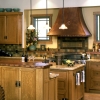In the twenty-first century, as the new "heart & hearth" of the home (a title previously held by the more romantic inglenook fireplace), the kitchen deserves to be as thoughtfully designed as any other room of the house. The first historical record of a stove being built refers to a stove constructed in 1490 in Alsace, France. The first kitchen hood was probably the chimney, since cooking was done in the fire itself. In 1900, the kitchen was sparse, to be used by the hired help or the lady of the house, hardly a concern was given to making it a pleasant or interesting space to inhabit. In "The Craftsman", Gustav Stickley's designs suggested that modernizing and applying the same principles to the utilitarian cooking room, would improve the health and happiness of the family.
Lamentably, today's stove hoods continue to be a neglected opportunity for creative expression and functionality in the kitchen. Most often, the humble hood, is considered a simple appliance, unworthy of the designer's attention, with little chance to lift itself to artistic consideration. Painted sheet-metal or stainless steel boxes, screwed to the wall, await their moment of glory, maybe sucking up some broccoli steam or, on a good day, some fish-fry grease! Even more out of place is a hood built out of wood, looking like a couple of cabinet doors trying to escape the confines of their open-and-shut existence. This treatment, or lack thereof, is out of place in the Arts & Crafts home, or any well-designed home, for that matter.
Without sensitive and thoughtful execution, as with many architectural features, hoods often end up cartoonish, with oddly-scaled elements and motifs garishly stuck to the surface to build a façade of Arts & Crafts style.
While hybridization of design is a healthy process by which art and design progress; for the Arts & Crafts home, mixing of styles should be done with a reserved touch and a sensitive eye to avoid awkward combinations that don't reflect the movement's core ideals of "honesty, simplicity, and usefulness."
There seem to be three approaches to Arts & Crafts design and production today:
A) Reproduction of the historical works of craftspeople, designers and architects of the early twentieth Century.
B) Working from the philosophical and aesthetic approach; developing a unique design "voice" for the character and treatment of the shapes and materials.
Both of these approaches are needed to grow and nurture Arts & Crafts as an ongoing living movement.
There is a third "Arts & Crafts" method that, in my opinion, should be avoided if possible, or at least, in fairness, renamed "Farce & Crass" or somesuch, to distinguish it from truer work. It is, essentially, pseudo Arts & Crafts: mass-produced, lifeless, without any mark or variation from the hand of the maker or the informed judgment of an eye that has carefully studied works of historical significance. It is, disappointingly, product created for the sake of product, a façade of a style, sequestered for the ungenuine application of a "look". In some cases the uncontrolled slathering of Arts & Crafts-ish-ness is tantamount to the bastardized combination, for example, of a Baroque or Edwardian design approach with the stylistic trappings of a craftsman bungalow.
If one follows this line of thinking then it may be argued that contemporary craftspeople, regardless of the particular "style" for which their work may have an affinity, are actually in much closer alignment with Arts & Crafts than mass-produced work that puts on the style but lacks any awareness of its core values.
"The essence and life of design lies in finding that form for anything which will, with the maximum of convenience and beauty, fit it for the particular functions it has to perform, and adapt it to the special circumstances in which it must be placed. Perhaps the most fruitful source whence charm of design arises in anything, is the grace with which it serves its purpose and conforms to its surroundings. How many of the beautiful features of the work of past ages, which we now arbitrarily reproduce and copy, arose out of the skillful and graceful way in which some old artist-craftsman, or chief mason, got over a difficulty! If, instead of copying these features when and where the cause for them does not exist, we would rather emulate the spirit in which they were produced, there would be more hope of again seeing life and vigor in our architecture and design." (Barry Parker & Raymond Irwin, "The Art of Building A Home" from The Craftsman)
Decoration, in and of itself, is not evil, but it must be used wisely and with a light touch. For the humble hood, adornment should be part of an integrated whole, within the panels, joinery or strapping. Understatement is paramount to the philosophy. When in doubt, leave it out.
"Simplicity, sincerity, repose, directness, and frankness are moral qualities as essential to architecture as to good men."
--C.F.A. Voysey, The English Home, 1911
Many may be tempted to carelessly load on decorative details to their hood, their kitchen, their home, and their life but beware! This leads to Gaudiness, which plays darts with Boondoggle at the tavern.





